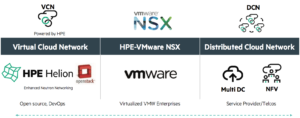HP Network Architectures

Hi everybody! Today we are going to present the main solutions proposed by our provider, HP, in terms of network architectures.
So basically we can break down Data Center architectures proposes by HP into four types:
- Layer 2 (L2) architectures
- Layer 3 (L3) architectures
- L3 with overlay solutions
- Multiprotocol Label Switching (MPLS) / Virtual Private LAN Service (VPLS)
L2 architectures are commonly implemented with 1-tier (flat network) topologies or 2-tier (spine and leaf) topologies. This kind of architectures lost prominence when networks grew and became much bigger, needing L3 designs to scale better and reduce broadcast domains. Despite that, the appearance of virtualisation caused the resurgence of full L2 solutions solving the scalability problem when combined with cloud computing, like the HPE Helion OpenStack® solution shows. These architectures use Transparent Interconnection of Lots of Links (TRILL), Intelligent Resilient Framework (IRF) and Shortest Path Bridging (SPB) technologies. TRILL is a mechanism that allows the optimal distribution of traffic and failure recovery with multipathing by giving to each device a tree view of the network rooted at itself. IRF is a network virtualisation technology which can connect multiple physical devices through specific IRF ports and emulating them as a single virtual device, allowing redundancy and scalability at the same time. SPB is an IEEE standard-based technology that simplifies the network provisioning system by only configuring the introduction of new VMs in the edge of the network. The combination of these technologies provide a no Spanning Tree Protocol, loop-free, scalable and multipathing Ethernet fabric network.
On the other hand, L3 architectures are implemented with 2-tier o 3-tier topologies. These became very popular before the proliferation of virtualisation thanks to its scaling and efficiency advantages but, after that, the need of VM migration-friendly environments reduced their prominence. HP's L3 solutions use OSPF and BGP routing protocols for an easier network routing scalability and configuration, which also let manipulate routes for particular requirements and load balancing. IRF is also used in these architectures as it is fully supported by L3 devices, creating large logical switches and routers that can be managed as one device and providing redundancy.
When comparing advantages from both solutions, L2 architectures offer lower capital expenditure, can be simpler to deploy and manage in small and medium sized Data Centers, supports VMs migration without having to change IP addressing and aggregate less latency to the network. Otherwise, L3 architectures reduce broadcast storms by segmenting its domains, deliver more efficient forwarding (traffic between VLANs don't need to travel to the core to get routed), offer better scale capabilities for large networks, achieve more efficient use of network uplinks (no loops need to be resolved) and provide more efficient troubleshooting capabilities thanks to segmentation.
But why do we have to decide between one or the other when we can deploy an overlay architecture? Overlay technologies let the company enjoy the benefits of L3 architectures while providing L2 connectivity for applications and devices within the DC. This is achieved by creating a virtual L2 network encapsulated inside an L3 architecture. Added to the technologies commented in the L3 solution, overlay architectures also use the Virtual Extensible LAN (VXLAN) paradigm to solve the problem of VM Mobility, network infrastructure MAC addresses and VLAN scalability limitations. It is achieved by decoupling VMs machines from the L3 network, so they communicate each other in the same L2 segment while obtaining isolation. In order to perform VXLAN encapsulation and de-encapsulation, VXLAN Tunnel Endpoint (VTEP) tunnels are configured within the network, which map VMs or physical devices to Virtual Network Identifier (VNI). This could create a multitenacy and scalability problem, which is mitigated by using MP-BGP as a VXLAN control plane protocol (EVPN).
When this architecture is combined with HPE's Virtual Cloud Networking (VCN) SDN and the HPE Distributed Cloud Networking, it allows overlay networks to be implemented in very large and scalable scenarios and multi-cloud environments. Also, a fully VM compatible solution can be achieved thanks to the HPE-VMWare NSX integration.
The last architecture offered by HP is the MPLS / VPLS solution, which uses "label switching" to transmit data across the network and avoids large routing tables int the core backbone of the enterprise. We will not explain in detail this solution as they are mainly used by carrier networks, not enterprises (which is our objective).
Finally, HP shows a brief guide that can help companies to decide which solution best fits their needs, as well as a table that describes the recommended technologies to be used in each solution.
It should be noted that despite IRF doesn't appear int he L3 overlay solution 1, it is actually used too, as well as TRILL is also implemented in Layer 2 solutions.
To conclude, given the requirements of our Data Center design for a bank that you can find in our previous posts, we opt for the L3 overlay architecture (at least for now) as it can merge both L2 and L3 advantages and offer better scalability. If you want to know more about HP Data Center Network Architecture, you can consult it here. And as always, feel free to leave a comment and share the post!
Se you soon!





Add new comment